高一英语必修一Unit3 Travel Journal Reading教学设计(终案)
高中英语人教版必修1教案: Unit 3 Travel Journal Reading 教案2
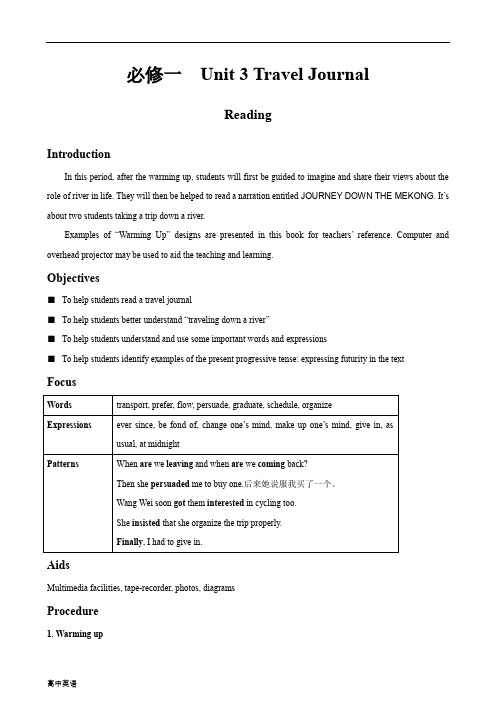
必修一Unit 3 Travel JournalReadingIntroductionIn this period, after the warming up, students will first be guided to imagine and share their views about the role of river in life. They will then be helped to read a narration entitled JOURNEY DOWN THE MEKONG. It’s about two students taking a trip down a river.Examples of “Warming Up”designs are presented in this book for teachers’reference. Computer and overhead projector may be used to aid the teaching and learning.Objectives■To help students read a travel journal■To help students better understand “traveling down a river”■To help students understand and use some important words and expressions■To help students identify examples of the present progressive tense: expressing futurity in the textFocusAidsMultimedia facilities, tape-recorder, photos, diagramsProcedure1. Warming up⑴Warming up by discussingGood morning, class. Do you like traveling? Why do you like traveling? And why don’t you like traveling? Where have you ever been before? How did you get there? If you are given a chance to travel around the world, what kind of transportations will you use and why? Now look at the following pictures and discuss it in pairs.⑵Warming up by looking and speakingNow boys and girls, what do you need to take with you if you are preparing for a bike trip along the Changjiang River? Look at the pictures and tell the whole class which object you think is the most useful and which one is the least useful. Give a reason why you think so.⑶Warming up by asking and answeringNow suppose you live in Qinghai. You plan to take a holiday with a friend somewhere in Southeast Asia. You have been given a chance to choose three places to visit. Please find out the one-way fare to get there for different kinds of transportation. Perhaps you may not know the exact fare, but you can guess how much the fare is. Please have a short discussion with your partners and then decide where to go.Ok, now I’d like you to ask your partner the following questions.2. Pre-reading by talking and sharingAs we all know, there are a lot of rivers in the world and also there are many great rivers. Now look at the chart. In the left column are names of some great rivers. In the right column are locations where the rivers lie. Please match them.3. Reading aloud to the recordingToday we’re going to read a passage about JOURNEY DOWN THE MEKONG. Please listen and read aloud about the recording of the text JOURNEY DOWN THE MEKONG on page 18. Pay attention to the pronunciation of each word and the pauses within each sentence. I will play the tape twice and you shall read aloud twice, too. 4. Reading and underliningNow please read and underline all the useful expressions or collocations in the passage. Copy them to your notebook after class as homework.5. Reading aloud once again and understandingNext we are going to read aloud the text once again and then answer some questions.1)Who are Wang Kun and Wang Wei? (They are brother and sister, and both are college students.)2)What was their dream? (Their dream was to take a great bike trip.)3)Who are Dao Wei and Yu Hang? (They are Wang Kun’s cousins who are at a college in Kunming.)4)Where is the source of the Mekong River and which sea does it enter? (The source of the river is in QinghaiProvince and it enters the South China Sea.)5)What can you see when you travel along the Mekong? (You can see glacier, rapids, hill, valleys,waterfalls and plains.)6)Is it a difficult journey to cycle along the Mekong? Why? (Yes. The journey begins at an altitude of more than5,000 meters, where it is hard to breathe and very cold.)6. Reading and summing upWe shall go over the text once more to complete the chart below.Type of writing and summary of the idea7. Making a diagram of the textNext try to turn out a diagram of the text to see its organization.8. Retelling the text with the help of the diagram in about 200 wordsRetelling can be fun and useful. Next we are to retell the story in the third person. And we shall make use of the diagram above.9. Discussing in groupsWe have got the general meaning of the passage, and we know Wang Wei and Wang Kun have some similar and different attitudes about the trip. You may have a short discussion with your partners and then fill in the chart.10. Closing down by taking a quiz。
教学设计21:Unit 3 Travel journal
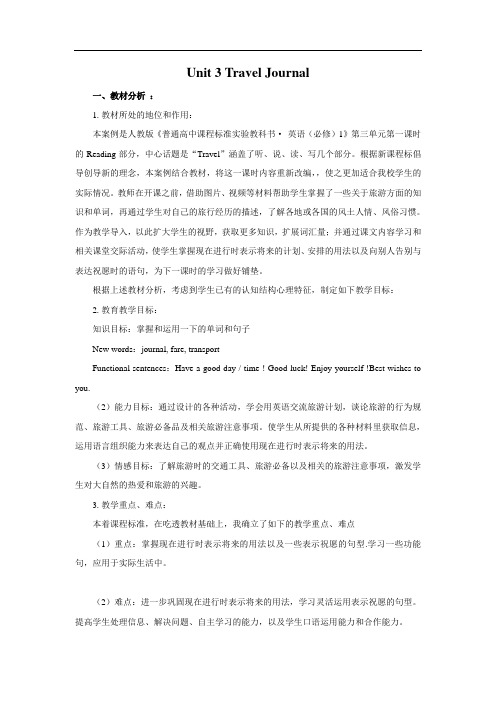
Unit 3Travel Journal一、教材分析:1. 教材所处的地位和作用:本案例是人教版《普通高中课程标准实验教科书·英语(必修)1》第三单元第一课时的Reading部分,中心话题是“Travel”涵盖了听、说、读、写几个部分。
根据新课程标倡导创导新的理念,本案例结合教材,将这一课时内容重新改编,,使之更加适合我校学生的实际情况。
教师在开课之前,借助图片、视频等材料帮助学生掌握了一些关于旅游方面的知识和单词,再通过学生对自己的旅行经历的描述,了解各地或各国的风土人情、风俗习惯。
作为教学导入,以此扩大学生的视野,获取更多知识,扩展词汇量;并通过课文内容学习和相关课堂交际活动,使学生掌握现在进行时表示将来的计划、安排的用法以及向别人告别与表达祝愿时的语句,为下一课时的学习做好铺垫。
根据上述教材分析,考虑到学生已有的认知结构心理特征,制定如下教学目标:2. 教育教学目标:知识目标:掌握和运用一下的单词和句子New words:journal, fare, transportFunctional sentences:Have a good day / time ! Good luck! Enjoy yourself !Best wishes to you.(2)能力目标:通过设计的各种活动,学会用英语交流旅游计划,谈论旅游的行为规范、旅游工具、旅游必备品及相关旅游注意事项。
使学生从所提供的各种材料里获取信息,运用语言组织能力来表达自己的观点并正确使用现在进行时表示将来的用法。
(3)情感目标:了解旅游时的交通工具、旅游必备以及相关的旅游注意事项,激发学生对大自然的热爱和旅游的兴趣。
3. 教学重点、难点:本着课程标准,在吃透教材基础上,我确立了如下的教学重点、难点(1)重点:掌握现在进行时表示将来的用法以及一些表示祝愿的句型.学习一些功能句,应用于实际生活中。
(2)难点:进一步巩固现在进行时表示将来的用法,学习灵活运用表示祝愿的句型。
人教版新课标英语必修一Unit3 Travel Journal reading 课程教学设计
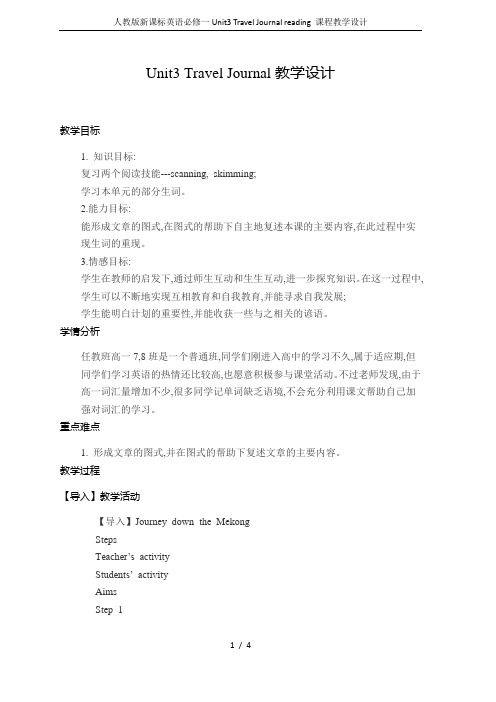
Unit3 Travel Journal教学设计教学目标1. 知识目标:复习两个阅读技能---scanning, skimming;学习本单元的部分生词。
2.能力目标:能形成文章的图式,在图式的帮助下自主地复述本课的主要内容,在此过程中实现生词的重现。
3.情感目标:学生在教师的启发下,通过师生互动和生生互动,进一步探究知识。
在这一过程中,学生可以不断地实现互相教育和自我教育,并能寻求自我发展;学生能明白计划的重要性,并能收获一些与之相关的谚语。
学情分析任教班高一7,8班是一个普通班,同学们刚进入高中的学习不久,属于适应期,但同学们学习英语的热情还比较高,也愿意积极参与课堂活动。
不过老师发现,由于高一词汇量增加不少,很多同学记单词缺乏语境,不会充分利用课文帮助自己加强对词汇的学习。
重点难点1. 形成文章的图式,并在图式的帮助下复述文章的主要内容。
教学过程【导入】教学活动【导入】Journey down the MekongStepsTeacher’s activityStudents’ activityAimsStep 1Show and tell the students the learning goals for them and make possible explanationsStudents listen to the teacher and have an idea of what they are going to learn in this class.To make the students know what they are to learn in this classStep 21). Show some pictures with beautiful scenery2) Ask the students two questions:Are they attractive?Where do you want to travel? –I dream about traveling…1.) Students appreciate those pictures2) Students answer teacher’s questions and practice the sentence pattern “I dream about traveling in/to…”1). To arouse students’ interest2) To practice a sentence patternStep 31). Show the title of the reading passage2). Ask the students whether this passage is about the whole process of the journey.3). Ask the students how to skim.4) Tell the students the skill of skimming on the screen1) Students answer the question after they read the subtitle of this part.2). Students tell how to skim.1) To make the students pay attention to the subtitle, which can tell the main idea of the passage.2) To review how to skimStep 41)Ask the students to skim more—to find out the main idea of each2)paragraph.1) Students tell the main idea of each paragraph1) To practice how to skimStep 5With four questions, teacher asks the students to scan paragraph 1Ask students how the scanShow the skills of scanning on the screenStudents scan paragraph 1, and answer the four questionsStudents tell how to scanTo review how to scanTo practice how to scanStep 61)Ask the students to scan paragraph 2 and find out what different2)attitudes Wang Kun and Wang Wei have, and then finish the table1) Students scan paragraph 2 and finish the table1) To practice how to scanStep 71)Provide the students with a picture which describes a geographic word as well as a few sentences about the flow of the Mekong river on each 2)slide and ask them to read the sentences.2) Ask the students to match each geographic word to the proper meaning s1) Students read the sentences loudly together and look at the pictures and the related geographic words in the meanwhile.2) Students do the matching work1) To better know how the Mekong river flows2) To help the students better learn the geographic words which are new to them3) To check how the students understand the new wordsStep 8Review the structure of the passage together with the students and show some key words on the screenProvide the students with some words and phrases which are the new words in this unitAsk them to retell the main content of the passage in groupsWith the teacher, students review the structure of the passageRetell the main content of the passage in groupsTo help students form the schema of the passage by reviewing the structure of itTo know the content of the passage better as well as to create more chances for the students to use the new wordsStep 91) Ask the students what they learn from the story2) Give the students some useful and related proverbs1) Students share their opinions with the group members what they have learned from the story.2) Students read the proverbs loudly together.1) To encourage students to form their own views and share them with others2) To learn some useful proverbsStep 101) Summarize this class by showing the learning goals。
高中英语人教版 必修1 Unit3 Travel journal Reading 教案
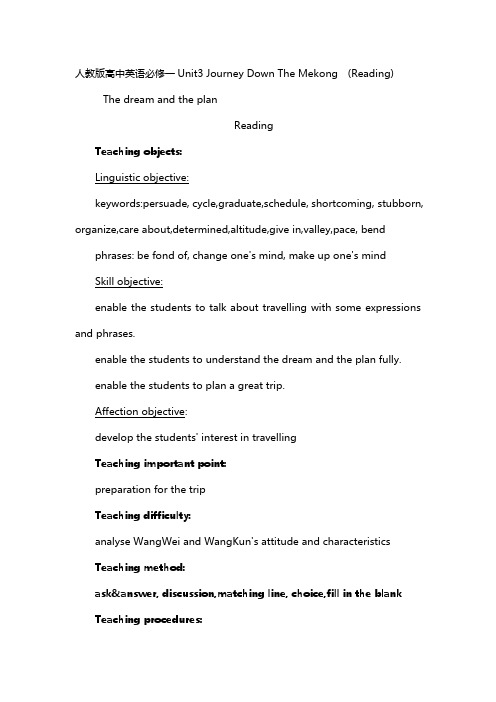
人教版高中英语必修一Unit3 Journey Down The Mekong (Reading) The dream and the planReadingTeaching objects:Linguistic objective:keywords:persuade, cycle,graduate,schedule, shortcoming, stubborn, organize,care about,determined,altitude,give in,valley,pace, bend phrases: be fond of, change one's mind, make up one's mindSkill objective:enable the students to talk about travelling with some expressions and phrases.enable the students to understand the dream and the plan fully.enable the students to plan a great trip.Affection objective:develop the students' interest in travellingTeaching important point:preparation for the tripTeaching difficulty:analyse WangWei and WangKun's attitude and characteristicsTeaching method:ask&answer, discussion,matching line, choice,fill in the blankTeaching procedures:Step1.leading-in &warming-up&pre-readingLead-into begin the class with the theme song of 'journey to the west' to arouse the students' interest in travelling and ask the student whether they like travelling and why.Lead the students to realize that they may suffer, get injured or enjoy a lot while travelling and help them build up an idea that it is necessary to make a plan before starting a trip.Warming-upquestion:Why do you like travelling?Task:answer teacher' question with the help of Chinese hint(提示)Because travelling can help me________发展友谊_________开拓眼________增长知识Because i can _________________in the travelling(享受美景)_________________享受生活———————获得乐趣What else?_________________了解风俗文化Pre-readingfinish the exercise about the Mekong river's background on P34 of the book《名师伴你行》Step2 Fast-readingto get the main idea of the passage and each paragraph and tell howfinish the exercise of the choice and matching line on P35(选择和连线)step3 Careful-readingPara1. main idea: the dream of taking a great bike triptask:in order to make the dream come true, what did we do ?list out a series of facts according to the ____clue(线索)。
高一英语必修一Unit3 Travel Journal Reading教学设计
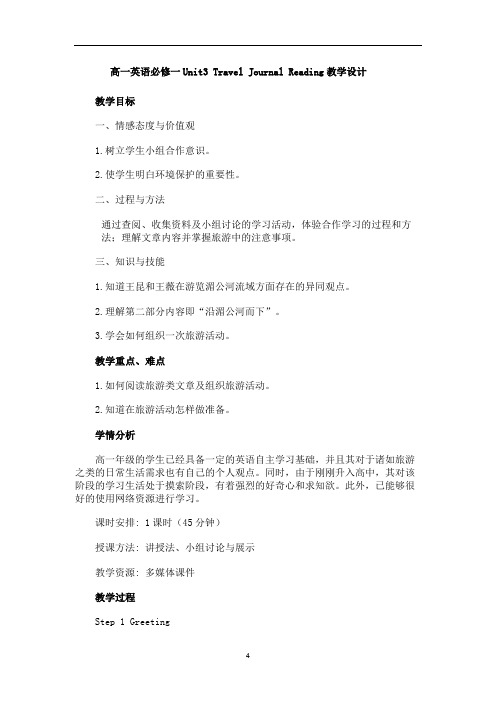
高一英语必修一Unit3 Travel Journal Reading教学设计教学目标一、情感态度与价值观1.树立学生小组合作意识。
2.使学生明白环境保护的重要性。
二、过程与方法通过查阅、收集资料及小组讨论的学习活动,体验合作学习的过程和方法;理解文章内容并掌握旅游中的注意事项。
三、知识与技能1.知道王昆和王薇在游览湄公河流域方面存在的异同观点。
2.理解第二部分内容即“沿湄公河而下”。
3.学会如何组织一次旅游活动。
教学重点、难点1.如何阅读旅游类文章及组织旅游活动。
2.知道在旅游活动怎样做准备。
学情分析高一年级的学生已经具备一定的英语自主学习基础,并且其对于诸如旅游之类的日常生活需求也有自己的个人观点。
同时,由于刚刚升入高中,其对该阶段的学习生活处于摸索阶段,有着强烈的好奇心和求知欲。
此外,已能够很好的使用网络资源进行学习。
课时安排: 1课时(45分钟)授课方法: 讲授法、小组讨论与展示教学资源: 多媒体课件教学过程Step 1 GreetingStep 2 RevisionT:First,I’ll ask some of you to give the answers to the exercises in Part 1 on Page 57.Suggested answers:are going/will go/am going to stay/will stay/am stayingis going to fly/will fly/is flyingis going to take/will take/is taking;leavesbought;will buy/are going to buy;met;will meet/are meeting/are going to meetStep 3 Lead inT:Here is good news.Your favorite singer Jay will give performances in Wuxi Stadium.But tomorrow you will take an English exam.What will you do?S1:Forget the exam and enjoy the concert first.S2:Forget the concert.Get well prepared for the exam.I can enjoy another concert of his some day.S3:...S4:...T:So we can see different students have different ideas,or different students hold different attitudes.(Write “holda...attitude” on the blackboard).Do you know what an attitude is?S:An attitude is what a person thinks about something.T:Yes,usually different people hold different attitudes.Let’s turn back to Part One of this unit and make a comparison between Wang Kung’s and Wang Wei’s attitudes toward the trip along the Mekong.Present the chart on the screen;then give Ss a few minutes to discuss.T:Now,who do you think was right about the trip?S:Wang Kung.T:Why?S:His attitude was more practical and it is always right to get well prepared before setting out for a trip.T:Quite right.Step 4 First readingT:Now I’d like you to read the second part of this unit,and find out the answers to the two questions:1.How does Wang Kung feel about the trip now?2.What do you think has changed his attitude?Ss read the passage silently with some light music being played.T:Are you ready now?S:He thinks the trip is full of fun and excitement and he is eager for it. T:How can you know?S:The text says:to climb the mountain was hard work,but to go down the hills was great fun.It also says:we can hardly wait to see them.The later sentence means that Wang Kung and his sister were eager to meet their cousins and set out for the trip.T:Good answer and good explanation.You see,he can read between the lines. Class,you should learn from him.Who will be a volunteer to answer the second question?S:I’ll try.At first,Wang Kung was not very eager for thetrip,because he thought the trip would not be very easy because of thin air and cold weather.But the different experiences on the way to the altitude have changed his attitude.T:Can you tell us what the different experiences are?S:The changeable weather,the ice in autumn,their living in the tent,and the unusual quietness at night.Step 5 Second-readingT:Suppose you have just come back from a trip,and you want to tell your e-pal about your trip,what will you tell him?S:Of course I’ll tell him what I have seen during the trip,wonderful sceneries,interesting people and customs.S:I will tell him what I eat;in some places there are special delicious food. S:I can also tell him what I hear and what I do.S:At the end of my e-mail,I’ll tell him what I feel about the trip.T:So you know what to write about when writing a traveljournal.And when reading such kind of articles,you also need to pay attention to these information.Please read the passage and fill in the chart.Suggested answers:(Chart two)Step 6 DiscussionT:We all know traveling is interesting and exciting,but sometimes dangerous. Now my question is:What can we do before we set out for a trip to make our trip a safe and pleasant one?Give Ss a few minutes to discuss.S1:I think we should first decide a proper destination.Think about our time and money,then find an ideal destination.S2:We should get to know the background information about the place we’ll visit,such as its language,history,culture,customs,religion,politics.S3:Decide what means of transport we will take to save money and time. S4:We’d better know about the weather there,so we can prepare proper clothes. T:Yes,proper clothes can keep you warm or cool.S5:I think a compass and a local map is always necessary in case that we lose our way.T:Good.And what else will take along with you?S6:Medicine.Someone may catch cold or get sunburn,or get bitten by mosquitoes.We can take some water-resistance sunscreen and insect repellent to avoid being bitten.S7:Maybe we can wear sunglasses or straw hats to protect ourselves from the sunshine.S8:We’d better take some food and drinks.S9:Take a cell phone with us.In case of emergency,we can get in touch with the police or relatives,thus we’ll get immediate rescue.T:(Present these information on the blackboard to make Ss remember them.The teacher can present the information in the form below:)T:I’d like to remind you that whenever you go,don’t forget to get your life insured.Step 7 Homework1.Imagine that the dialogue happens the next morning before Wang Kung and Wang Wei leave their camp.Some of you write one short dialogue between them,and practice it.2.Finish workbook exercise Part 1 “Using words and expressions” on Pages 56-57.板书设计 Module1 Unit 3 Trave JournalThe Fourth Period Readingchart 1 chart 2activity1... activity3... activity2... activity4...。
高中英语人教版必修1教案: Unit 3 Travel Journal Reading 教案1

必修一Unit 3 Travel JournalReadingTeaching goals教学目标1.Target language目标语言a. 重点词汇和词组dream about, finall y, persuade, stubborn, insist, properly, determined, attitude, change one’s mind, give in.b. 重要句式Ever since middle school, my sister Wang Wei and I have dreamed about taking a great bike trip.Two years ago she bought an expensive mountain bike and then she persuaded me to buy one.It was my sister who first had the idea to cycle along the entire Mekong River from where it begins to where it ends.Although she didn’t know the best way of getting to places, she insisted that she organize the trip properly.She gave me a determined look – the kind that said that she would not change her mind.Once she has made up her mind, nothing can change it.We were both surprised to learn that half of the river is in China.2. Ability target 能力目标Enable the students to conclude Wang Wei’s and Wang Kun’s attitude to the trip and then add their own opinion with the target language.3. Learning ability goals学能目标Enable the students to learn how to conclude Wang Wei’s and Wang Kun’s attitudes about trip.Teaching important points 教学重点To comprehend the text is very important. Get Ss to express their plans and wishes. Help them learn that traveling is a good way to widen one view and add to one knowledge.Teaching difficult points 教学难点How to grasp the ma in idea of the text and how to tell the writer’s attitudeTeaching methods 教学方法Talking, discussing, readingTeaching aids教学工具a tape recorder, a projector and a computerTeaching procedures & ways 教学过程和方法Step 1 Greeting and leading-inT: Good morning / afternoon.S: Good morning / afternoon, Sir / Madam.T: Boys and girls, Do you like traveling?Ss: Yes.T: Where have you been before?S1: I’ve been to Beijing, and Huangshan.T: How did you find your travel to Beijing?S1: Very interesting. It helped me learn about the history of Beijing. As the capital of our motherland, it is really beautiful. The deepest impression on me is the visit to the Great Wall and the Forbidden City. But it was a pity that time was too short. We had no chance to go sightseeing in other places of interest.S2: I went to Xiameng last year. I think the travel to Xiameng was busy. We visited many places, such as Wuyi Mountain, Putuo Temple, Ningbo and so on. Though we had a good time, in fact, most of the time was spent on trains. That was boring and tiring. I felt a bit sorry.T: It’s a pity. If you had made a proper plan before traveling, your journey would have been much more comfortable and interesting. Do you think so?S2: I agree with you.T: How do you like travel?S3: In my opinion, travel is interesting and helpful. When I travel I can learn a lot. I can enjoy local customs, cultures and beautiful scenery.T: I also think so. Well, after we choose a place to travel, we must choose a kind of transport which kind of transport do you prefer to use: bus or train? Now, please work with your partners and think about the advantages and disadvantages of each form of transport and fill in the chart on page 17.Five minutes later, check the Ss’ answersT: Ok. We’ve w eighed the advantages and disadvantages of each form of transport. Now, imagine that you plan tospend a holiday. Choose a place you want to visit. Think about the fare for different kinds of transport and decide how to get there. You may not know the exact fare, but you can guess how much the fare is. Please have a discussion with your partners and then decide how to get there.Two minutes later, ask a pair of students to report their decisions.T: Since yo u’ve decided how to get there, I’d like you to talk more about your holidays. Then use these questions on the screen to make a dialogue about your holidays with your partners.Show the screen.Ss are given one minute to practice. Then ask some pairs to act out their conversationsSa: Tom, where are you going on holiday?Sb: I’m going to Laos.Sa: When are you leaving?Sb: Next Sunday.Sa: How are you going to Laos?Sb: I’m taking a plane.Sa: How long are you staying there?Sb: About two weeks.Sa: Great. Have a good trip.Sb: Thanks.Step 2 Pre-readingT: Well done! Do you like traveling along a river, a great river?Ss: Yes.T: By the way, what role does a river play in people’s life? In other words, how do people who live along a river use it?S1: People use a river to irrigate their fields.S2: People use a river to make electricity.S3: People go swimming in the river in summer. They can float wood down a river.S4: They can travel along a river.T: You are right. As we know the world has many rivers. It even has many great rivers. What makes a river great, in your opinion?S4: A great river is very important.S5: A great river is very large and longTeacher shows a chart with some great rivers in the worldT: Now please look at the chart. In the left column are names of some great rivers. In the right column are the locations where the rivers lie. Please match them.After Ss complete the chart, Teacher can show the correct answers in another chart. Then Teacher should ask Ss some more questions about the rivers.T: Does anyone know anything else about the rivers?S6: The Seine River. I t locates in France. It’s the mother river of France.S7: I know som ething about the Nile. It’s the world’s longest rive r. It flows through Egypt.S8: I have some idea about the Amazon. It’s the world’s largest river. It’s in Brazil.The correct answers:T: OK, if you could travel down only one of them, which one would you choose, and why?S9: I’d like to travel down the Seine. So I can see much beautiful scenery in Europe. I can enjoy the Eiffel Tower. S10: I’d ra ther go along the Nile, where I can see many wild animals. I can learn about customs and cultures in Africa. I can also see the great dam, Aswan.T: Do you know the Mekong River?S11: Yes. But I only know it locates in Southeast Asia.T: It does n’t matter. Now let’s look at t he map on Page 18. Will you please find out the countries that the Mekong River flows through?Ss: China, Vietnam and Laos.Step 3 Reading and comprehendingT: Great. Now let’s read a passage about a journey down the Mekong River.Please read the p assage and get a main idea of the text. Let’s learn more about the Mekong River. Then I’d like to ask you some questions on the text.Show the questions on the screen. Give the Ss five minutes to read the passage and then check their answersT: You know Wang Kun and Wang Wei are brother and sister. What was their idea of a good trip?S1: They have dreamed about taking a great bike trip.T: Who planned the trip to the Mekong?S2: Wang Wei.T: What about Question 3?S3 The source of the Mekong River is in Qinghai Province and it enters the South China Sea.T: How about Question 4?S4: We can see a glacier, deep valleys, waterfalls, hills and plains.T: What difficulties did Wang Kun and Wang Wei find about their journey?S5: We know that the travelers had to climb over a Tibetan mountain and pass through deep valleys.T: You are right. Have you ever thought of traveling by bike?Ss: Yes/no.T: What do you think about Wang Kun and Wang Wei?S6: I think they are energetic and determined.T: Quite right. N ow I’d like you to tell Wang Wei’s and Wang Kun’s similar and different attitudes about the trip. You can have a discussion with your partners. And then fill in the chart. By the way, do you know the word “attitude”? An attitude is what a person thinks about something. Let’s start.Two minutes is enough. Teacher checks the answers and writes them down on the blackboard while the students are telling their answers.T: Do you agree with them? S: Yes.T: OK. Another question. Who do you think was right about the trip? Why?S: I think Wang Kun was right, because if it is too cold and too high, the trip will be hard. People will have some difficulty in breathing at a high altitude. Wherever we go we need an atlas so that we will not lose our way. Step 4 ExplanationDuring the procedure Teacher will ask Ss to read the text carefully and pay attention to the words in bold in the text and underline the sentences they don’t understand. Then Teacherwill do some explanations, deal with language problems in the text, and at the same time mention Ss to refer to Notes 5 to10 on P 81. Next Teacher plays the tape.T: Well, everyone. Let’s read the text again. Please read carefully and focus our attention on the details and the sen tences you don’t understand. Underline the sentences you don’t understand. Please go ahead. Five minutes later.T: Finished? Do you have any problems?S1: Yes. In the sentence “She insisted that we find the source of the river and begin our journey there.” the verb “insist” is used in the past definite tense, while “find” is in the original form of a verb. It seems that they don’t agree with each other.S2: I don’t understand the sentence “She gave me a determined look – the kind that said she wouldn’t change her mind.” What’s the meaning of “the kind”?T: O K. let me do some explanations and deal with the difficult language points.T: Well, anything else?Ss: No.T: It’s time to do practice. Work in pairs. Imagine that you are Wang Kun and Wang Wei. Choose a paragraph from the passage and use the information to help you make up a dialogue. Two minutes later, I’ll ask a pair of students to act out your dialogue.A sample:Wang Wei: You know, w e’ve always wanted to do a long bike trip. Why don’t we go on one after we graduatefrom college?Wang Kun: That’s a good idea. Where are we going?Wang Wei: Why not cycle along the entire Mekong River from where it begins to where it ends?Wang Kun: Well. We should plan it well.Wang Wei: Let me plan our schedule. I can organize the trip properly.T: Good. Sit do wn, please. Now it’s time to deal with Exercise 5 on page 19. Compare the following sentences with different stresses and explain the meaning. Follow the example.Two minutes later.T: Now, who’d like to explain the first sentence? Volunteer!S1: I think it says: I t’s a surprise to learn that half the river is in China.T: Quite right. Sentence Two?S2: We were both surprised to learn that the Chinese part of the river forms a half of the river.T: Ok. The last sentence.S3: We were both surprised to learn that it is in china that half the river is.T: Good. We can see that different stresses express different meanings of the narrator.Step 5 Summing up and homeworkT: This class we hav e grasped the main idea of the text, the usage of some words and phrases. We’ve also learned about traveling. That is: before traveling we should make good preparations—making a plan, decide the place to visit and get enough information about the place. With full preparations we’ll have a good time during the trip. Here is your homework. Please go over the text after class, and complete the exercise on P 56 in workbook. All right, boys and girls, that’s all for today.。
必修一 Unit 3 Travel journal教学设计
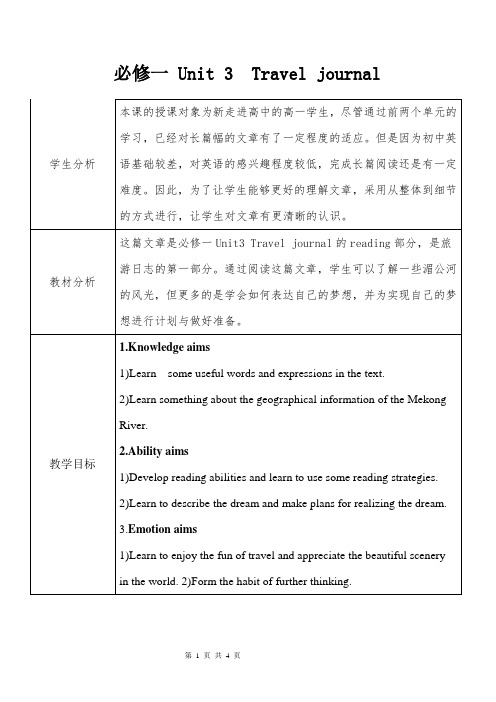
巩固本节课所学知识
让学生在对文章了解的基础上有更深入的理解,培养学生独立思考和简单的推理能力
Step 4 Summing up
Summarize the passage by filling in the blanks(If time permits,do it in class.If not,let the Ss do it as their homework).
教学策略
1.自主学习策略:通过背单词及新课的预习,对阅读内容有大致的了解,有助于新课的学习。
2.启发式教学策略:引导学生思考问题,回答问题。
3.合作学习策略:通过小组及同桌合作学习,培养合作学习、互帮互助的精神,也更有助于培养学习英语的兴趣。
教学准备
1.布置预习作业(请学生在课前背诵好上节课所学单词,并预习课文内容)。
1.Skim the passage and find out the main idea of the passage and each paragraph.
2.Read the passage again and answer some questions.
3.Fill in the blanks
必修一 Unit 3 Travel journal
学生分析
本课的授课对象为新走进高中的高一学生,尽管通过前两个单元的学习,已经对长篇幅的文章有了一定程度的适应。但是因为初中英语基础较差,对英语的感兴趣程度较低,完成长篇阅读还是有一定难度。因此,为了让学生能够更好的理解文章,采用从整体到细节的方式进行,让学生对文章有更清晰的认识。
Fill in the blanks.
重新梳理一遍文章的主体内容
人教版英语必修一Unit 3(Reading)实用教案
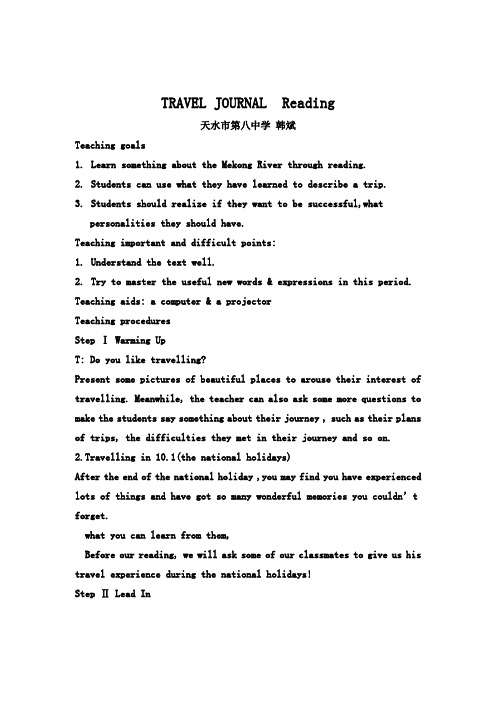
TRAVEL JOURNAL Reading天水市第八中学韩斌Teaching goals1.Learn something about the Mekong River through reading.2.Students can use what they have learned to describe a trip.3.Students should realize if they want to be successful,whatpersonalities they should have.Teaching important and difficult points:1.Understand the text well.2.Try to master the useful new words & expressions in this period. Teaching aids: a computer & a projectorTeaching proceduresStep Ⅰ Warming UpT: Do you like travelling?Present some pictures of beautiful places to arouse their interest of travelling. Meanwhile, the teacher can also ask some more questions to make the students say something about their journey , such as their plans of trips, the difficulties they met in their journey and so on.2.Travelling in 10.1(the national holidays)After the end of the national holiday ,you may find you have experienced lots of things and have got so many wonderful memories you couldn’t forget.what you can learn from them,Before our reading, we will ask some of our classmates to give us his travel experience during the national holidays!Step Ⅱ Lead InT: Q1:Have you visited any river? Q2: How many great rivers do you know? Q3: If you could travel down only one of them, which one would you choose? Why?Ask the students the locations of some famous rivers in theworld .(Mekong, Rhein, Seine, Nile, Thames, Congo, Amazon, Mississippi, blog)Step Ⅲ Pre-readingT: Have you visited the Mekong River? If no, let’s learn something about it.1. Show a picture of the Mekong River and the brief introduction of it. Ask them:2. Can you list the countries that the Mekong River flows through?3.Enjoy the beautiful sights along the Mekong River to arouse theirinterest of it.4.Travel journalWe could find if you are living in the Tailand, The air quality is fresh and the environment is wonderful for there are less pollution, what’s more, the working pressure is low, people could do whatever they like to do in their free time.Every year, many tourists from other countries will travel to the Meikong river to enjoy the beautiful scenery, they have never seen before, with the assistance of the local guide, they find that Tailand is one of the world wonders on the earth.The environment around the Meikong river can’t be described in words, you can only feel it by using your own heart, what’s more, people living there are hospital and ready to help others if you are in trouble, they will always like to help strangers even they don’t know each other. Before reading, I will show you some wonderful picture of this on wangkun and his sister wangwei’s experience and travel route on their traveljournal. First of all ,we should remember this saying, “there must be one soul on the road, traveling or reading, by traveling ,we could get many practical experience ; By reading, we could also get useful wisdom ”Step IV ReadingIn this step, get the students to read the text and finish some tasks. Task1: Scan the text quickly, then answer some questionsQ1. Who are Wang kun and Wang Wei?Q2.What are their dreams?Q3.Who are Dao Wei and Yu Hang?Q4. Is it a difficult journey to cycle along the Mekong? Why?Q5.What can you see when you travel along the Mekong River?Task2: Listen to the tape and pay attention to the pronunciation, then do the T or F exercise.1.Wang kun is a high school student.2.Both Dao Wei and Yu Hang are Dai and they grew up in eastern Yunnan province3.The source of Mekong is in Qinghai province .4.Finally Wang Kun agreed with his sister to cycle with her.5.They found few atlas and books about Mekong River in library.6. Mekong river begins at glacier on a Tibet mountain. the water there is clear but not cold.7.Only a small part of the river is in China.8.As it enters Southeast Asia, it moves slowly.Task3: Careful readingRead the text again and try to complete a form.Task4: ConsolidationFill in the blanksMekong River begins ___ a glacier on a Tibetan mountain. At first ,The river is small and the water begins to move_______. It becomes ______as it passes ______ deep valleys. Traveling ______western Yunnan Province. Sometimes The River ______ wide Valley and becomes a_________. We were both surprised to learn that half of the river is in China . After it leaves china and the high altitudes, the Mekong becomes _____ , brown and warm. As it enters Southeast Asia, it travels slowly _________hills and low valleys, and the _____ where rice grows. at last the river’s delta enters the South China Sea.Step V Post-readingTask1:Make comparisonAn attitude is what a person thinks about something. Make lists of Wang Wei’s and Wang Kun’s similar and different attitudes about the trip. Task2: DebateWhich character do you like,Wang Kun or Wang wei? Why?Read the passage carefully and answer the following questions.1.what was wangkun and wangwei’s idea of a good trip?2.who planned the trip to the mekong?3.where is the source of the mekong and which does it enters?4.what can you see when you travel along the mekong?Task3: Understand two mottosLife is just a series of trying to make up your m ind.Success belongs to the persevence长难句分析1.After graduating from college, we finally got the chance to take a bike trip.在大学毕业以后,我们最终有了一个机会去做一个长途的自行车旅行。
人教版高中英语必修一 教案: Unit 3 Travel Journal Reading 3
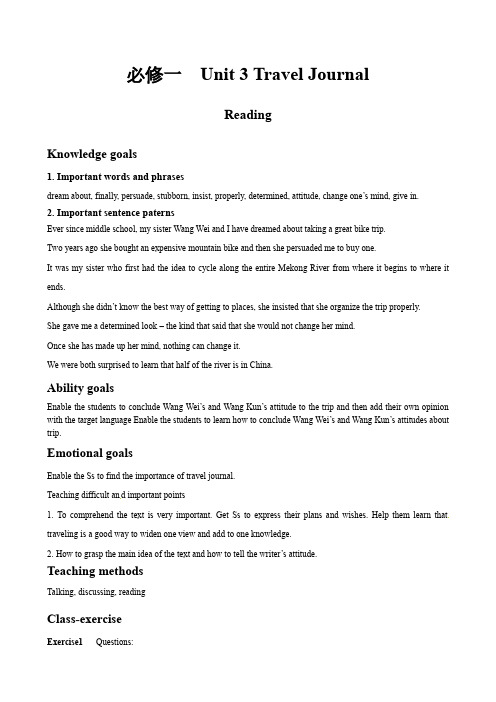
必修一Unit 3 Travel JournalReadingKnowledge goals1. Important words and phrasesdream about, finally, persuade, stubborn, insist, properly, determined, attitude, change one’s mind, give in.2. Important sentence paternsEver since middle school, my sister Wang Wei and I have dreamed about taking a great bike trip.Two years ago she bought an expensive mountain bike and then she persuaded me to buy one.It was my sister who first had the idea to cycle along the entire Mekong River from where it begins to where it ends.Although she didn’t know the best way of getting to places, she insisted that she organize the trip properly.She gave me a determined look – the kind that said that she would not change her mind.Once she has made up her mind, nothing can change it.We were both surprised to learn that half of the river is in China.Ability goalsEnable the students to conclude Wang Wei’s and Wang Kun’s attitude to the trip and then add their own opinion with the target language Enable the students to lea rn how to conclude Wang Wei’s and Wang Kun’s attitudes about trip.Emotional goalsEnable the Ss to find the importance of travel journal.Teaching difficult an d important points1. To comprehend the text is very important. Get Ss to express their plans and wishes. Help them learn that traveling is a good way to widen one view and add to one knowledge.2. How to grasp the main idea of the text and how to tell the writer’s attitude.Teaching methodsTalking, discussing, readingClass-exerciseExercise1 Questions:1.What was Wang Kun and Wang Wei’s idea of a good trip?2.Who planned the trip to the Mekong?3.Where is the source of the Mekong River and which sea does it enter?4.What ca n you see when you travel along the Mekong River?5.What difficulties did Wang Kun and Wang Wei find about their journey?What do you think about Wang Kun and Wan g Wei?T: You know Wang Kun and Wang Wei are brother and sister. What was their idea of a good trip?S1: They have dreamed about taking a great bike trip.T: Who planned the trip to the Mekong?S2: Wang Wei.T: What about Question 3?S3 The source of the Mekong River is in Qinghai Province and it enters the South China Sea.T: How about Question 4?S4: We can see a glacier, deep valleys, waterfalls, hills and plains.T: What difficulties did Wang Kun and Wang Wei find about their journey?S5: We know that the travelers had to climb over a Tibetan mountain and pass through deep valleys.T: You are right. Have you ever thought of traveling by bike?Ss: Yes/no.T: What do you think about Wang Kun and Wang Wei?S6: I think they are energetic and determined.T: Quite right. Now I’d like you to tell Wang Wei’s and Wan g Kun’s similar and different attitudes about the trip. You can have a discussion with your partners. And then fill in the chart. By the way, do you know the word “attitude”? An attitude is what a person thinks about something. Let’s start.Two minutes is enough. Teacher checks the answers and writes them down on the blackboard while the students are telling their answers.。
人教版高中英语必修1教案Unit 3 Travel Journal

人教版高中英语必修1教案Unit 3 Travel Journal一、教学目标1.学习和掌握本单元的重点词汇和短语;2.理解并能正确运用学过的语法知识,如现在完成时等;3.能够流利地描述旅行中的经历,并表达自己对旅行的感受和看法。
二、教学内容1.重点词汇和短语:travel, journal, destination, journey, adventure, accommodation, sightseeing, scenic spot, tourist, attractions, brochure, brochure, souvenir, local, tradition;2.语法:现在完成时的构成和用法;3.阅读和写作:阅读和理解旅行日记,模仿写作旅行日记。
三、教学过程1. 导入新课老师通过展示一些美丽风景的照片来引起学生的兴趣,激发学生对旅行的兴趣,并谈论一些他们自己的旅行经历。
2. 词汇和短语学习老师通过PPT展示教材中的重点词汇和短语,并帮助学生理解和记忆。
学生可以带着课本,一起跟读和练习。
3. 语法学习老师给出现在完成时的定义和用法,并在白板上列出肯定、否定和疑问句的构成和例句。
老师解释时态中的时间状语的使用和位置,并通过举例子帮助学生理解。
4. 阅读和写作练习•老师给学生分发几篇关于旅行的日记,让学生进行阅读,并回答一些问题。
•学生根据给出的要点,模仿写一篇旅行日记。
•老师分组让学生互相交流并修改彼此的日记。
•学生在组内互相朗读自己的日记,并进行点评。
四、教学评价教师通过学生课堂表现、参与度以及小组内的互动来评价学生的学习情况。
同时,教师检查学生书写的旅行日记是否条理清晰、语法用法是否准确,并给予相应的反馈和指导。
五、拓展活动为了拓展学生的知识和兴趣,老师可以组织学生进行有关旅行的问答比赛,或者带领学生参观当地的旅游景点,增加实践和体验的机会。
六、总结通过本节课的学习,学生能够掌握旅行相关的词汇和短语,理解并运用现在完成时的语法知识,并能够写一份简单而有条理的旅行日记。
新编人教版高中英语必修1教案: Unit 3 Travel Journal Reading 教案5 Word版

必修一Unit 3 Travel JournalReadingTeaching goals1. To have a better understanding of the main idea of the passage.2. To conclude Wang Wei’s and Wang Kun’s attitudes toward the trip3. To talk about how to prepare for the travel journal both on physical and material aspects.Language focus (here are some language items and structures)New words: persuade; stubborn; properly; determined;change her mind; give in.Teaching aidsComputer, recorder and projectorTeaching proceduresStep 1. I.Pre-reading1. The world has many great rivers. Ask the students if they could travel down only one of them, which one would they choose? Why?通过多媒体向学生提供一些风景名胜的图片引导其进行热烈地讨论。
T: Ask the students to guess the names of the rivers.S: Try to name the rivers.(A map of China and some pictures of the rivers are shown on the screen..)(通过地图以及河流的图片来增长学生的地理知识,从而引发学生的兴趣,从而引出课题。
(完整word版)人教版高中英语必修1Unit3说课稿
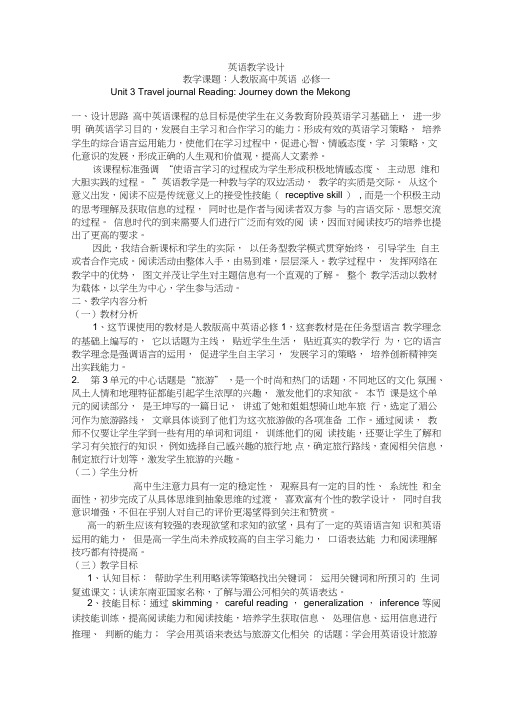
英语教学设计教学课题:人教版高中英语必修一Unit 3 Travel journal Reading: Journey down the Mekong一、设计思路高中英语课程的总目标是使学生在义务教育阶段英语学习基础上,进一步明确英语学习目的,发展自主学习和合作学习的能力;形成有效的英语学习策略,培养学生的综合语言运用能力,使他们在学习过程中,促进心智、情感态度,学习策略,文化意识的发展,形成正确的人生观和价值观,提高人文素养。
该课程标准强调“使语言学习的过程成为学生形成积极地情感态度、主动思维和大胆实践的过程。
”英语教学是一种教与学的双边活动,教学的实质是交际。
从这个意义出发,阅读不应是传统意义上的接受性技能(receptive skill ), 而是一个积极主动的思考理解及获取信息的过程,同时也是作者与阅读者双方参与的言语交际、思想交流的过程。
信息时代的到来需要人们进行广泛而有效的阅读,因而对阅读技巧的培养也提出了更高的要求。
因此,我结合新课标和学生的实际,以任务型教学模式贯穿始终,引导学生自主或者合作完成。
阅读活动由整体入手,由易到难,层层深入。
教学过程中,发挥网络在教学中的优势,图文并茂让学生对主题信息有一个直观的了解。
整个教学活动以教材为载体,以学生为中心,学生参与活动。
二、教学内容分析(一)教材分析1、这节课使用的教材是人教版高中英语必修1,这套教材是在任务型语言教学理念的基础上编写的,它以话题为主线,贴近学生生活,贴近真实的教学行为,它的语言教学理念是强调语言的运用,促进学生自主学习,发展学习的策略,培养创新精神突出实践能力。
2. 第3单元的中心话题是“旅游” ,是一个时尚和热门的话题,不同地区的文化氛围、风土人情和地理特征都能引起学生浓厚的兴趣,激发他们的求知欲。
本节课是这个单元的阅读部分,是王坤写的一篇日记,讲述了她和姐姐想骑山地车旅行,选定了湄公河作为旅游路线,文章具体谈到了他们为这次旅游做的各项准备工作。
北师大版高中英语必修一第三单元教案
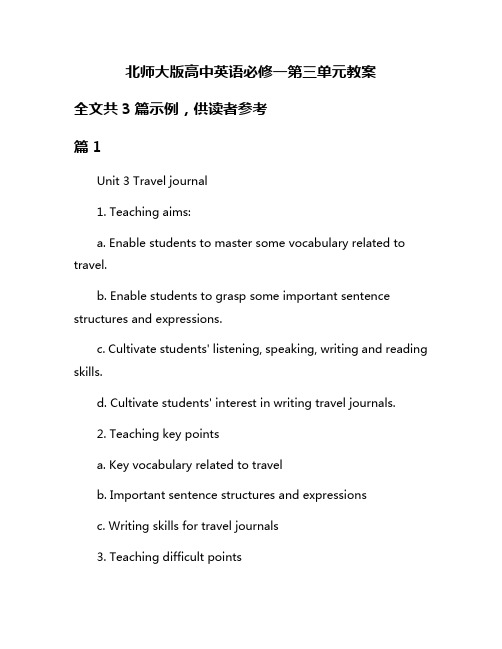
北师大版高中英语必修一第三单元教案全文共3篇示例,供读者参考篇1Unit 3 Travel journal1. Teaching aims:a. Enable students to master some vocabulary related to travel.b. Enable students to grasp some important sentence structures and expressions.c. Cultivate students' listening, speaking, writing and reading skills.d. Cultivate students' interest in writing travel journals.2. Teaching key pointsa. Key vocabulary related to travelb. Important sentence structures and expressionsc. Writing skills for travel journals3. Teaching difficult pointsa. How to use the vocabulary and sentence structures in practical situations.b. How to write a coherent and interesting travel journal.4. Teaching aidsa. Multimedia resourcesb. Whiteboard and markers5. Teaching proceduresStep 1: Warm-up (10 minutes)a. Show students some pictures of famous tourist attractions around the world and ask them if they have ever been to any of them.b. Discuss with students the reasons why people travel and the benefits of traveling.Step 2: Vocabulary learning (15 minutes)a. Introduce some key vocabulary related to travel, such as "destination", "sightseeing", "accommodation", "itinerary", etc.b. Have students practice using the vocabulary in sentences.Step 3: Listening and speaking practice (20 minutes)a. Play a recording of a travel journal entry and have students listen carefully.b. Ask students to discuss in pairs or small groups about their own travel experiences and share them with the class.Step 4: Writing practice (30 minutes)a. Introduce the format and structure of a travel journal entry.b. Have students write their own travel journal entry about a trip they have taken or would like to take.c. Provide feedback and corrections on students' writing.Step 5: Review and assessment (15 minutes)a. Review the key vocabulary and sentence structures learned in the lesson.b. Have students present their travel journal entries to the class for assessment.6. Homeworka. Ask students to continue their travel journal entries at home and bring them to the next class for review.b. Assign some exercises related to the vocabulary and sentence structures learned in the lesson for further practice.Through this lesson, students will not only improve their English language skills, but also develop a greater appreciation for the art of travel journal writing.篇2北师大版高中英语必修一第三单元教案Unit 3 Travel journalⅠ. Teaching aims and requirements1. Knowledge aims:(1) Get to know some news words: trek, snowcapped, spiritual, kingdom, Kingdom, camel.(2) Understand the main idea of each para., comprehend some detailed information to Mary and Mood.(3) Practice reading skills: skimming and scanning.2. Ability aim:Improve students’ abilities of listening, speaking, reading and wring. Learn how to express travel through it.3. Emotion aim:(1) Cultivate students’ travel mind and prepare their travel ideas.(2) Learn to respect, peaceful and grateful.4. Moral aim:Learn to natural world to love, to know animals and treasure life’s creatures.Ⅱ. Teaching key points1. Summary the passage: Why does Mary Bishop come to the Nepal Himalaya?2. How did she feel after leaving the snow-capped mountain?3. What about another member’s mood?Ⅲ. Teaching difficult points1. Improve students’ summarizing ability.2. Ingrain climate.Ⅳ. Teaching aidsA recorder, a computer and multi-media.Ⅴ. Teaching methodsTask-based teaching. Communicative approach.Ⅵ. Teaching proceduresStep Ⅰ: Lead-in1. Show some cards about the animals and choose the most important animal in their heart.2. Ask: Why do they feel meet?3. Listen to the tape for warming up.Step Ⅱ: Pre-reading.Predict what they may feel during trekking in the Himalayas and give their an example then scan Task1Q1.Step Ⅲ: Reading1. Students read the passage quickly and choose the answer about Mary loses while trekking.2. To teacher’s questions: What’s wrong with Mary’s friend?3. Analyze detailed information of Mood.4. Check the work and ask some questions to each other and fill in the blanks.Step Ⅳ: Comprehension1. Listen to Task2Q2 to particular. They can draw a map to explain that she arrives in Jiri and then to Sethopsar.2. Find the detailed from the passage and fill in the blanks.3. Pair works to discuss mood for 2 minutes.Step Ⅴ: Language practice1. Help student to speak: In pairs. Practice speaking these dialogues.2. To help them to translate Chinese into English.Step Ⅵ: SummaryAsk students to try their best to speak in English about their thoughts when meet animals in trekking.Step Ⅶ: Homework1. Choose another paragraph to summarize.2. Writing an essay with their parents talking about experience of trekking.Ⅶ. Blackboard designUnit 3 Travel JournalMain Idea: Why does Mary Bishop come to the Nepal Himalaya?a) ...........b)...............c)…………Task 1Fill in the blanks.1. The writer saw many ---------.2. There was a dog following the trek who tried to--------.3. In the evening, they camped in a beautiful ---------.Task 2Write down your answers in the passage.1. Travel to Tsomanthang.2. Go to Sethopsar.ConclusionImprove students' summarizing and comprehension abilities.篇3Lesson 3 One's company, two's a crowd, three's a party【Teaching Aims】1. Enable students to master the key words and expressions in the text.2. Improve students' listening, speaking, reading and writing skills.3. Develop students' ability to express their opinions and thoughts in English.4. Cultivate students' understanding of different cultures and social norms.【Teaching Key Points】1. Key words and expressions in the text.2. Listening comprehension.3. Speaking practice based on the text.4. Writing a short paragraph expressing personal opinions.【Teaching Difficult Points】1. Listening comprehension.2. Expressing personal opinions and thoughts in English.【Teaching Methods】1. Task-based teaching method.2. Group discussion.3. Pair work.4. Role play.5. Multimedia teaching.【Teaching Procedures】Step 1: Greeting and warm-up (5 minutes)- Greet the students and introduce the topic of the lesson.- Ask students to discuss in pairs: "What do you think makes a good party?"- Have a brief class discussion to share ideas.Step 2: Pre-reading task (10 minutes)- Ask students to look at the title of the text and predict what it might be about.- Play a short video clip of a party scene and ask students to describe what they see and how they feel.Step 3: Reading and listening (20 minutes)- Read the text aloud and ask students to read along silently.- Play the audio recording of the text for students to listen and follow.- Discuss the main ideas, key words, and expressions in the text.Step 4: Reading comprehension (15 minutes)- Divide students into pairs or small groups to discuss and answer the comprehension questions.- Check the answers as a class and provide feedback.Step 5: Speaking practice (20 minutes)- Divide students into groups and assign roles for a role play activity about planning a party.- Encourage students to use the key words and expressions from the text in their conversations.- Monitor and provide feedback on their speaking skills.Step 6: Writing (15 minutes)- Ask students to write a short paragraph expressing their opinions on the importance of social gatherings.- Collect and review the paragraphs for grammar and vocabulary errors.Step 7: Summarizing and homework (5 minutes)- Summarize the key points of the lesson and ask students to review the text for homework.- Assign a writing task for students to write a party invitation using the key words and expressions from the text.【Teaching Reflection】This lesson aims to engage students in a variety of activities to improve their English skills while exploring the theme of social gatherings. By focusing on listening, speaking, reading, and writing tasks, students are able to practice and consolidate their language skills in a meaningful context. The use of multimedia and interactive activities helps to create a dynamic and engaging learning environment.。
Unit 3 Travel journal-Reading 英语教案高中英语人教新课标必修一

Unit 3 Travel Journal(Reading)附课堂练习题Objectives:Students will be able to read and comprehend a travel journal entry about a cultural experience. Students will be able to identify the author's purpose and point of view in the text.Students will be able to use descriptive language to write a travel journal entry of their own. Students will be able to use vocabulary in context and identify synonyms and antonyms.Materials:The textbook "High School English - People's Education Press New Standard Curriculum - Book 1, Unit 3"Whiteboard and markersHandout with vocabulary exercisesComputer and projectorProcedure:Step 1: Warm-upAsk students to share any interesting travel experiences they have had.Write down their ideas on the board.Step 2: Pre-readingAsk students to look at the title of the text and predict what the text is about.Ask students to skim the text and look at the pictures and captions to make guesses about the content.Ask students to define key vocabulary from the text.Step 3: ReadingDisplay the text on the screen and ask students to read it silently.Ask students to underline or highlight key vocabulary words.Ask students to read the text aloud, taking turns with their classmates.Ask students to answer the comprehension questions in pairs.Check the answers as a class.Step 4: Vocabulary exercisesHand out the vocabulary exercises and ask students to complete them.Check the answers as a class.Step 5: Writing activityAsk students to imagine they are traveling to a new country and write a travel journal entry about their cultural experience.Remind them to use descriptive language and include sensory details (sight, sound, smell, taste, touch) to make their writing more engaging.Step 6: Post-writing sharingAsk students to share their travel journal entries with a partner.Ask students to give feedback to their partner, focusing on the descriptive language used.Assessment:Teacher observation during class discussion and group work.Completion of the vocabulary exercises.Quality of writing in the travel journal entry.Homework:Ask students to research a country they are interested in visiting and write a short paragraph about a cultural experience they would like to have while there.Here are some exercises that can be used to reinforce the learning objectives of the lesson:Synonyms and Antonyms: Give students a list of vocabulary words from the reading and ask them to find a synonym and antonym for each word. For example:Synonym for "exotic": foreign, unusual, uniqueAntonym for "mundane": ordinary, routine, commonplaceAuthor's Purpose and Point of View: Provide students with a short passage and ask them to identify the author's purpose and point of view. For example:"The purpose of this travel journal entry is to share my experience of attending a traditional festival in Japan. My point of view is that the festival was a fascinating and enriching cultural experience."Author's Purpose: To share a cultural experience.Point of View: The festival was fascinating and enriching.Descriptive Language: Ask students to write a short paragraph describing a place they have visited using sensory details. For example:"I visited a small fishing village on the coast of Maine. As I walked along the rocky shoreline, I could smell the salty sea air and hear the waves crashing against the rocks. Seagulls cried overhead as fishermen hauled in their catch for the day. I tasted fresh lobster and clams at a local seafood shack, and felt the cool ocean breeze on my skin."Vocabulary in Context: Provide students with a passage from the reading and ask them to use context clues to determine the meaning of unfamiliar vocabulary words. For example:"The exotic sights and sounds of the local market filled me with wonder and awe. The vibrant colors of the spices and fabrics, the spicy aromas of the street food, and the cacophony of voices in different languages all combined to create a truly unforgettable experience."Unfamiliar Vocabulary Words: cacophonyMeaning: a harsh, discordant mixture of soundsReflection: Ask students to reflect on their own travel experiences and write a short paragraph about what they have learned about other cultures through their travels.。
英语人教必修一Unit-3-Travel-Journal-【教学设计】

Unit 3 Travel Journal教材分析本单元的话题是旅游,学生对此话题较为熟悉,应该有较浓厚的兴趣。
整个单元讲述的是主人公“王坤”以旅行日记的形式详细地记录自己沿着湄公河而下的自行车旅行。
学生通过追随作者的旅行,学习及探讨与旅游相关话题和内容,如:了解旅游常识,如何设计旅行计划,如何为旅行做准备,旅行的意义等。
通过本单元的学习,学生不仅能掌握与旅游及地理相关的主题词汇,理解和运用现在进行时表示将来的语法项目,还会通过探讨旅游话题了解世界各地的文化,增强对祖国河山的热爱和国际意识,进而开拓学生思路,培养学生的跨文化交际能力。
Warming up 部分先让学生分享国庆假期的游玩经历,引导学生探讨节假日旅行的利与弊。
通过对比分析几种常见交通方式的利弊,择优选择自己旅行的最佳出行方式,并尝试为自己设计旅行计划。
Reading部分先通过Pre-reading的问题,引导学生关注世界各大河流及人类对河流的利用,和理解湄公河在东南亚的地位及对东南亚各国人民的重要作用。
课文主要介绍了主人公王坤和王薇的梦想及骑自行车沿着湄公河旅行的计划和准备。
在整体理解课文主要内容后重点引导学生分析王坤和王薇两位主人公的性格及对旅行的不同态度。
Learning about Language以文本核心单词与词组为直接学习内容,加强学生的英英释意习惯,让学生学会利用字典及参考书进行自主归纳与学习。
在本课时的词汇学习中强调在语境中正确理解和运用词汇;Using Language集听、说、读、写于一体。
先通过读旅行日记的第二部分来了解其文体特征及内容、听一段关于王坤与老挝女孩的一段对话、探讨自己对老挝感兴趣的话题,写一封email询问王坤的旅行情况;Grammar是学习现在进行时表示将来的用法,并进行操练。
引导学生通过观察对比例句,总结归纳现在进行时表将来的用法及规律,并在生活情境中正确运用该语法项目。
在本单元的Learning Tip中给学生提出写旅行日志的方法和好处,鼓励学生外出旅行时写旅游日志(travel journal).教学目标(1)学习理解旅行日记Journey down the Mekong的行程及主人公的所见所闻;(2)能够熟练掌握并运用现在进行时表示将来的语法项目;(3)帮助学生掌握正确的旅游常识,及培养学生的安全意识及保护自然的责任感。
高中英语 Unit 3 Travel journal Reading教案 新人教版必修1
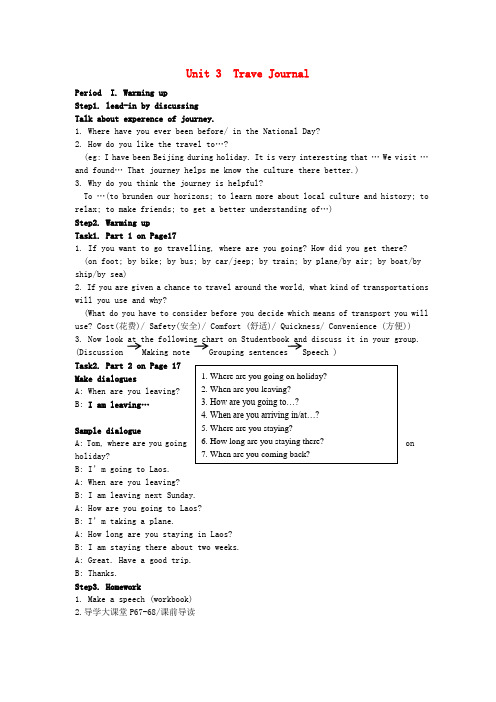
Unit 3 Trave JournalPeriod I. Warming upStep1. lead-in by discussingTalk about experence of journey.1. Where have you ever been before/ in the National Day?2. How do you like the travel to…?(eg: I have been Beijing during holiday. It is very intere sting that … We visit …and found… That journey helps me know the culture there better.)3. Why do you think the journey is helpful?To …(to brunden our horizons; to learn more about local culture and history; torelax; to make friends; to get a better und erstanding of…)Step2. Warming upTask1. Part 1 on Page171. If you want to go travelling, where are you going? How did you get there?(on foot; by bike; by bus; by car/jeep; by train; by plane/by air; by boat/byship/by sea)2. If you are given a chance to travel around the world, what kind of transportationswill you use and why?(What do you have to consider before you decide which means of transport you willuse? Cost(花费)/ Safety(安全)/ Comfort (舒适)/ Quickness/ Convenience (方便)) 3. Now look at the following chart on Studentbook and discuss it in your group.(Discussion Making note Grouping sentences Speech )Task2. Part 2 on Page 17Make dialoguesA: When are you leaving?B: I am leaving…Sample dialogueA: Tom, where are you going onholiday?B: I’m going to Laos.A: When are you leaving?B: I am leaving next Sunday.A: How are you going to Laos?B: I’m taking a plane.A: How long are you staying in Laos?B: I am staying there about two weeks.A: Great. Have a good trip.B: Thanks.Step3. Homework1. Make a speech (workbook)2.导学大课堂P67-68/课前导读Period II. Reading(1)Step1.RevisionMake a speech on Page55 WorkbookStep2. Lead-in1. Do you like traveling along a river, a great river? What role does a river play in people’s life? In other words, how do people who live along a riv er use it?2. Where there is a river, there is a city.As we all know, there are a lot of rivers in the world and also there are many great rivers. Now look at the chart. In the left column are names of some great rivers. In the right column are locations where the rivers lie. Please match them. Names of River LocationMekong China,SE Asia / Rhine Germany / GangesIndia/Seine France / Nile Egypt/ Thames England/ Congo Central Africa/ Niger West Africa/ Volga Russia/ Danube Central Europe/ Amazon Brazil/ Mississippi US/ Step 3. Pre-reading 3 on page17Now look at the map of the Mekong River and point out the countries it flows through. (China, Laos, Thailand, Cambodia, Burma Vietnam)Step 4. Reading1.Skimming. Find out the main ideas of each paragraph.Para.1Wang Kun and Wang Wei’s dream.Para.2 Wang Wei is stubborn.Para.3 Preparing for their trip.2.Careful reading. Answer the queations of part 1 on P19 \《导学大课堂》课前导读1)Who are Wang Kun and Wang Wei? (They are brother and sister, and both are collegestudents.)2)What was their dream? (Their dream was to take a great bike trip.)3)Who are Dao Wei and Yu Hang? (They are Wang Kun’s cousins who are at a collegein Kunming.)4)Where is the source of the Mekong River and which sea does it enter?(The sourceof the river is in Qinghai Province and it enters the South China Sea.)5)What can you see when you travel along the Mekong?(You can see glacier,rapids, hill, valleys, waterfalls and plains.)6)Is it a difficult journey to cycle along the Mekong? Why? (Yes. The journey beginsat an altitude of more than 5,000 meters, where it is hard to breathe and very cold.)3.Sentences patterns.1. Ever since middle school, my sister Wang Wei and I have dreamed about takinga great bike trip. 从中学起, 我姐姐王薇和我梦想作一次了不起的自行车旅行。
- 1、下载文档前请自行甄别文档内容的完整性,平台不提供额外的编辑、内容补充、找答案等附加服务。
- 2、"仅部分预览"的文档,不可在线预览部分如存在完整性等问题,可反馈申请退款(可完整预览的文档不适用该条件!)。
- 3、如文档侵犯您的权益,请联系客服反馈,我们会尽快为您处理(人工客服工作时间:9:00-18:30)。
高一英语必修一Unit3 Travel Journal Reading教学设计(终案)教学目标一、情感态度与价值观1.树立学生小组合作意识。
2.使学生明白环境保护的重要性。
二、过程与方法通过查阅、收集资料及小组讨论的学习活动,体验合作学习的过程和方法;理解文章内容并掌握旅游中的注意事项。
三、知识与技能1.知道王昆和王薇在游览湄公河流域方面存在的异同观点。
2.理解第二部分内容即“沿湄公河而下”。
3.学会如何组织一次旅游活动。
教学重点、难点1.如何阅读旅游类文章及组织旅游活动。
2.知道在旅游活动怎样做准备。
学情分析高一年级的学生已经具备一定的英语自主学习基础,并且其对于诸如旅游之类的日常生活需求也有自己的个人观点。
同时,由于刚刚升入高中,其对该阶段的学习生活处于摸索阶段,有着强烈的好奇心和求知欲。
此外,已能够很好的使用网络资源进行学习。
课时安排1课时(45分钟)授课方法讲授法、小组讨论与展示教学资源多媒体课件教学过程Step 1 GreetingStep 2 RevisionT:First,I’ll ask some of you to give the answers to the exercises in Part 1 on Page 57.Suggested answers:are going/will go/am going to stay/will stay/am stayingis going to fly/will fly/is flyingis going to take/will take/is taking;leavesis giving;is sayingam comingare;going;are;gettingbought;will buy/are going to buy;Step 3 Lead inT:Here is good news.Your favorite singer Jay will give performances in Wuxi Stadium.But tomorrow you will take an English exam.What will you do?S1:Forget the exam and enjoy the concert first.S2:Forget the concert.Get well prepared for the exam.I can enjoy another concert of his some day.S3:...S4:...T:So we can see different students have different ideas,or different students hold different attitudes.(Write “hold a...attitude” on the blackboard).Do you know what an attitude is?S:An attitude is what a person thinks about something.T:Yes,usually different people hold different attitudes.Let’s turn back to Part One of this unit and make a comparison between Wang Kung’s and Wang Wei’s attitudes toward the trip along the Mekong.Suggested answer:T:Now,who do you think was right about the trip?S:Wang Kung.T:Why?S:His attitude was more practical and it is always right to get well prepared before setting out for a trip.Step 4 First readingT:Now I’d like you to read the second part of this unit,and find out the answers to the two questions:1.How does Wang Kung feel about the trip now?2.What do you think has changed his attitude?Ss read the passage silently with some light music being played.T:Are you ready now?S:He thinks the trip is full of fun and excitement and he is eager for it.T:How can you know?S:The text says:to climb the mountain was hard work,but to go down the hills was great fun.It also says:we can hardly wait to see them.The later sentence means that Wang Kung and hissister were eager to meet their cousins and set out for the trip.T:Good answer and good explanation.You see,he can read between the lines.Class,you should learn from him.Who will be a volunteer to answer the second question?S:I’ll try.At first,Wang Kung was not very eager for the trip,because he thought the trip would not be very easy because of thin air and cold weather.But the different experiences on the way to the altitude have changed his attitude.T:Can you tell us what the different experiences are?S:The changeable weather,the ice in autumn,their living in the tent,and the unusual quietness at night.T:Good,you read the text very carefully.Step 5 Second-readingT:Suppose you have just come back from a trip,and you want to tell your e-pal about your trip,what will you tell him?S:Of course I’ll tell him what I have seen during the trip,wonderful sceneries,interesting people and customs.S:I will tell him what I eat;in some places there are special delicious food.S:I can also tell him what I hear and what I do.S:At the end of my e-mail,I’ll tell him what I feel about the trip.T:So you know what to write about when writing a travel journal.And when reading such kind of articles,you also need to pay attention to these information.Please read the passage and fill in the chart.(Chart one)feel(legs) heavy and coldTo climb the mountain was hard work,but to go down the hillswas great fun.can hardly wait to see their cousins设计意图:通过假设现实情景,引发学生思考一次旅游活动的所见、所闻、所做、所感。
同时,要求学生按照该思路重新阅读课文并填充表格,使学生犹如身临其境般领略教材内容。
Step 6 DiscussionT:We all know traveling is interesting and exciting,but sometimes dangerous.Now my question is:What can we do before we set out for a trip to make our trip a safe and pleasant one?Give Ss a few minutes to discuss.S1:I think we should first decide a proper destination.Think about our time and money,then find an ideal destination.S2:We should get to know the background information about the place we’ll visit,such as its language,history,culture,customs,religion,politics.S3:Decide what means of transport we will take to save money and time.S4:We’d better know about the weather there,so we can prepare proper clothes.T:Yes,proper clothes can keep you warm or cool.S5:I think a compass and a local map is always necessary in case that we lose our way.T:Good.And what else will take along with you?S6:Medicine.Someone may catch cold or get sunburn,or get bitten by mosquitoes.We can take some water-resistance sunscreen and insect repellent to avoid being bitten.S7:Maybe we can wear sunglasses or straw hats to protect ourselves from the sunshine.S8:We’d better take some food and drinks.S9:Take a cell phone with us.In case of emergency,we can get in touch with the police or relatives,thus we’ll get immediate rescue.T:(Present these information on the blackboard to make Ss remember them.The teacher can present the information in the form below:)设计意图:教师通过提问及学生讨论展示的形式,了解学生对教材的理解,弄清其对旅游活动准备情况所做的计划,并提示其在旅游过程中注意安全等问题。
